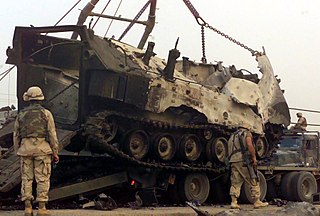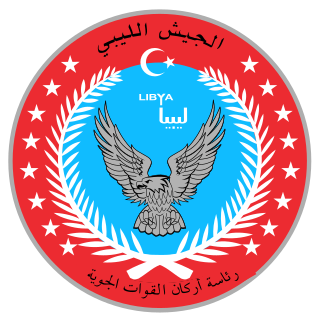
Sangin is a town in Helmand province of Afghanistan, with a population of approximately 20,000 people. It is located on 32°4′24″N64°50′2″E in the valley of the Helmand River at 888 m (2,913 ft) altitude, 95 km (59 mi) to the north-east of Lashkargah. Sangin is notorious as one of the central locations of the opium trade in the south of the country, and is also a town that has traditionally supported the Taliban. It was described by British newspaper The Guardian as "the deadliest area in Afghanistan" in 2010. Sangin also houses the main bazaar for Sangin District. Route 611 passes through Sangin.

The Battle of Nasiriyah was fought between the US 2nd Marine Expeditionary Brigade and Iraqi forces from 23 March to 2 April 2003 during the US-led invasion of Iraq. On the night of 24–25 March, the bulk of the Marines of Regimental Combat Team 1 passed through the city over the bridges and attacked north towards Baghdad. However, fighting continued in the city until 1 April when Iraqi resistance in the city was defeated.

Sirte, also spelled Sirt, Surt, Sert or Syrte, is a city in Libya. It is located south of the Gulf of Sirte, between Tripoli and Benghazi. It is famously known for its battles, ethnic groups, and loyalty to Muammar Gaddafi. Due to developments in the First Libyan Civil War, it was briefly the capital of Libya as Tripoli's successor after the Fall of Tripoli from 1 September to 20 October 2011. The settlement was established in the early 20th century by the Italians, at the site of a 19th-century fortress built by the Ottomans. It grew into a city after World War II.

The Libyan Air Force is the branch of the Libyan Armed Forces responsible for aerial warfare. In 2010, before the Libyan Civil War, the Libyan Air Force personnel strength was estimated at 18,000, with an inventory of 374 combat-capable aircraft operating from 13 military airbases in Libya. Since the 2011 civil war and the ongoing conflict, multiple factions fighting in Libya are in possession of military aircraft. As of 2019 the Libyan Air Force is nominally under the control of the internationally recognised Government of National Accord in Tripoli, though the rival Libyan National Army of Marshal Khalifa Haftar also has a significant air force. In 2021, the air force is under command of the new President of Libya, Mohamed al-Menfi that replaced Fayez al-Sarraj.

An Islamist insurgency is taking place in the Maghreb region of North Africa, followed on from the end of the Algerian Civil War in 2002. The Algerian militant group Salafist Group for Preaching and Combat (GSPC) allied itself with al-Qaeda to eventually become al-Qaeda in the Islamic Maghreb (AQIM). The Algerian and other Maghreb governments fighting the militants have worked with the United States and the United Kingdom since 2007, when Operation Enduring Freedom – Trans Sahara began.
There were 2,459 United States military deaths in the War in Afghanistan, which lasted from October 2001 to August 2021. 1,922 of these deaths were the result of hostile action. 20,769 American servicemembers were also wounded in action during the war. In addition, 18 Central Intelligence Agency (CIA) operatives also died in Afghanistan. Further, there were 1,822 civilian contractor fatalities.
The Ballygawley bus bombing was a roadside bomb attack by the Provisional Irish Republican Army (IRA) on a bus carrying British soldiers in Northern Ireland. It occurred in the early hours of 20 August 1988 in the townland of Curr near Ballygawley, County Tyrone. The attack killed eight soldiers and wounded another 28. In the wake of the bombing, the British Army began ferrying its troops in and out of County Tyrone by helicopter.

The Libyan Armed Forces or the Libyan Arab Armed Forces are, in principle, the state organisation responsible for the military defence of Libya, including ground, air and naval forces.

The Libyan civil war (2014–2020), also more commonly known as the Second Libyan Civil War, was a multilateral civil war which was fought in Libya between a number of armed groups, but mainly the House of Representatives (HoR) and the Government of National Accord, for six years from 2014 to 2020.

The Shura Council of Benghazi Revolutionaries was a military coalition in Benghazi composed of Islamist and jihadist militias, including Ansar al-Sharia, Libya Shield 1, and several other groups.
This is a detailed timeline of the Libyan civil war (2014–2020) which lasted from 2014 to 2020.

The Battle of Sirte during the Second Libyan Civil War started in the spring of 2016, in the Sirte District of Libya, between the Islamic State of Iraq and the Levant (ISIL) and the loyalist forces of the Government of National Accord (GNA) backed by the United States. ISIL forces had captured Sirte one year earlier, during the previous battle. The conflict for Sirte was described as ISIL's "last stand" in Libya.
Clashes occurred in western Libya since 14 October 2016, when a coup d'état attempt was conducted by the former head of the National Salvation Government (GNS), Khalifa al-Ghawil, against Prime Minister Fayez al-Sarraj, the head of Libya's Government of National Accord (GNA). This evolved into fighting between the GNA and GNS for control of Tripoli and parts of western Libya, while pro-GNA militias also attacked other militias for control of the region.

From November 2015 to 2019, the United States and allies carried out a large series of both airstrikes and drone strikes to intervene in Libya in its revived conflict in support of the Tripoli-based Government of National Accord against the ISIL presence in the region. By 2019, the ISIL branch had been largely driven from holding Libyan territory, and US strikes ceased.

In late January 2019, the Libyan National Army (LNA) led by Marshal Khalifa Haftar launched an offensive to take control of the city of Sabha and the rest of southern Libya from the internationally recognised Government of National Accord (GNA) and local factions. Officially, the LNA announced that the reason for the operation was to remove terrorists, Chadian rebel groups, and to secure the border, but it has expanded Haftar's territorial control and acquired him oil fields near Sabha. It has also restarted some interethnic conflicts as the LNA has allied with local Arab tribes, while the Tuareg and Toubou tribal militias are loyal to the GNA.

The Western Libya campaign was a military campaign initiated on 4 April 2019 by the Operation Flood of Dignity of the Libyan National Army, which represents the Libyan House of Representatives, to capture the western region of Libya and eventually the capital Tripoli held by the United Nations Security Council-recognised Government of National Accord. The Government of National Accord regained control over all of Tripoli in June 2020 and the LNA forces withdrew from the capital, after fourteen months of fighting.

The Central Libya offensive, officially known as Operation Paths to Victory, was a military offensive in Libya launched by the forces of the Government of National Accord, to take the city of Sirte and Al Jufra Airbase from the House of Representatives backed by the Libyan National Army. The city of Sirte is considered strategically important because of its close position to oil facilities, which give it control over Libya's oil and gas shipping ports. The Al Jufra Airbase is strategically important for the GNA, due to its central position to Fezzan and denying the Libyan National Army air superiority over Central Libya.

An Islamist insurgency has been ongoing in the Sahel region of West Africa since the 2011 Arab Spring. In particular, the intensive conflict in the three countries of Mali, Niger and Burkina Faso has been referred to as the Sahel War.
The Battle of Gharyan, which unfolded from April 2019 to June 2019, was a significant conflict in the ongoing struggle for control in Libya. The opposing forces were the Libyan National Army (LNA), led by General Khalifa Haftar, and the Government of National Accord (GNA), headed by Prime Minister Fayez al-Sarraj.













